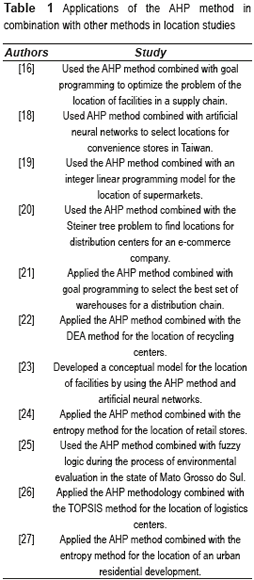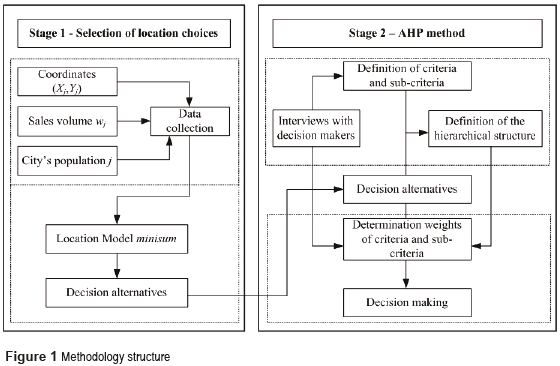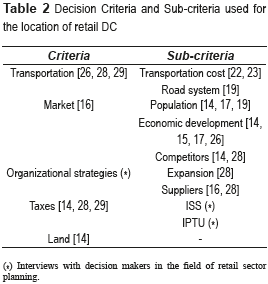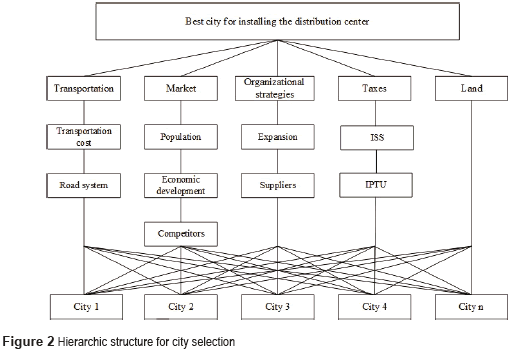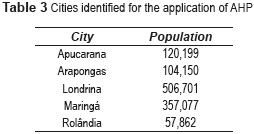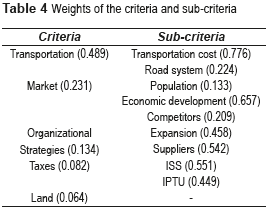Services on Demand
Journal
Article
Indicators
-
 Cited by SciELO
Cited by SciELO -
 Access statistics
Access statistics
Related links
-
 Cited by Google
Cited by Google -
 Similars in
SciELO
Similars in
SciELO -
 Similars in Google
Similars in Google
Share
Revista Facultad de Ingeniería Universidad de Antioquia
Print version ISSN 0120-6230
Rev.fac.ing.univ. Antioquia no.74 Medellín Jan./Mar. 2015
ARTÍCULO ORIGINAL
A two-stage decision support model for a retail distribution center location
Un modelo de apoyo a la toma de decisión en dos etapas para la localización de un centro de distribución para el sector minorista
Marcia Danieli Szeremeta-Spak, João Carlos Colmenero*
Graduate Program in Production Engineering (PPGEP), Federal University of Technology - Paraná. Campus Ponta Grossa. Av. Monteiro Lobato, 4, PR, 84016-210. Paraná, Brazil.
* Corresponding author: João Carlos Colmenero, e-mail: colmenero@utfpr.edu.br
(Received March 11, 2014; accepted October 10, 2014)
Abstract
This paper proposes a model to support the decision-making process of selecting the location of a distribution center for the retail sector. The model was structured in two stages to consider objective and subjective criteria (multicriteria) for the decision-making process. In the first stage, a nonlinear programming model was used to establish a reference site in the region under analysis and identify five cities near that location. The second stage consisted of building a hierarchic structure for making decisions based on criteria and sub-criteria relevant to the process of deciding the location of a distribution center, and applying the Analytic Hierarchy Process (AHP) multicriteria method for all five previously selected candidate cities. The model was used to define the location of a distribution center for a furniture and appliance retailer in the state of Paraná, Brazil. The results show that the criteria transportation and market have the most influence in the decision-making process, and that the best alternative for the distribution center was the city of Arapongas (PR). The methodology proved to be efficient in the decision analysis presented herein.
Keywords: Decision making, location problem, distribution center, Analytic Hierarchy Process, nonlinear programming
Resumen
El presente estudio tuvo como objetivo proponer un modelo de apoyo a la toma de decisiones para el problema de localización de centros de distribución para el sector minorista. El modelo fue construido en dos etapas con el propósito de considerar tanto los factores objetivos como los subjetivos (multicriterio) en el proceso de toma de decisiones. En la primera etapa se utilizó un modelo de programación no lineal para definir un sitio de referencia en la región bajo análisis y identificar cinco ciudades cercanas a esta ubicación. La segunda etapa consistió en la construcción de una estructura jerárquica de decisiones basada en criterios y subcriterios pertinentes para el proceso de toma de decisiones de localización de centros de distribución, y la aplicación del método multicriterio Proceso de Análisis Jerárquico (AHP) para las cinco ciudades candidatas previamente seleccionadas. El modelo se utilizó para definir la ubicación de un centro de distribución de una empresa del sector de muebles y electrodomésticos en el estado de Paraná, Brasil. Los resultados muestran que los criterios Transporte y Mercado son los más influyentes en el proceso de toma de decisiones, y la mejor alternativa para la instalación del centro de distribución fue la ciudad de Arapongas (PR). La metodología ha demostrado ser eficaz para la solución del problema de análisis de decisión presentado en este estudio.
Palabras clave: Toma de decisiones, problema de localización, centros de distribución, proceso de análisis jerárquico, programación no lineal
Introduction
The retail sector represents a large share of the Brazilian economy. Nevertheless, high costs of the distribution system impact the performance of that segment. The country's vast territory and the need to service several different retail locations in various regions, combined with high transportation costs, represent a challenge for organizations in that sector. The location of distribution centers (DCs) stands out among possible solutions for distribution problems.
The location of DCs must come from strategic decisions. The financial resources associated with this type of decision, as well as land and construction costs, make this an investment with long-term returns [1-3]. DCs must be located to meet the demands of the regions served by them and be near suppliers, with the possibility of increasing the level of service obtained by expanding the number of facilities or by placing them closer to clients [4-6].
In complex scenarios such as selecting the location of facilities, it becomes necessary to use tools structured to support decision making. Several methodologies can be used to select the location of facilities, according to the complexity of the problem at hand. The main ones include continuous models and multicriteria decision-making methods.
Continuous location models consist of allocating facilities within a continuous solution space - that is, at any point within the region under consideration (analytical plan). The objective of continuous location models is to minimize the sum of Euclidean distance between facilities and points of service [7].
Multicriteria methods stand out by considering the subjectivity inherent to decision processes. Their formulation contemplates all important variables and parameters, including qualitative characteristics of a subjective nature, thereby resulting in more dynamic decision making. By applying these methods, it becomes possible to analyze the context of decision making as a whole - identifying factors that influence the decision process and viable alternatives, to achieve coherence between initial object and final results [8, 9].
One of the main multicriteria decision-making method is AHP (Analytic Hierarchy Process). The AHP method undertakes a hierarchic representation of the elements involved in the process, to better visualize the decision-making context. Its approach consists of defining the problem or objective, determining which criteria and sub-criteria influence decision making, identifying which alternatives make it possible to achieve the goal, comparing pairs among the criteria to define priorities, and calculating the consistency index for all criteria [10, 11].
Decomposition into hierarchic levels facilitates analysis and priority-setting, and ordering the different criteria allows decision makers to understand the problem at hand [1]. The objective of this decomposition is to visualize the importance of the elements within themselves and in relation to other levels. In this analysis, the proper data must be identified to allow decision makers to correctly establish their preferences among the alternatives [12].
When building the hierarchy, priorities are established by comparing each element, pair by pair, within its hierarchic level, using a square decision matrix to define overall priorities and then rank the different alternatives to the problem [13]. A paired comparison of the choices is carried out based on a numerical scale (usually nine points) known as fundamental scale or Saaty scale [12].
AHP has been used in several decision-making studies to determine the location of facilities. [14] applied the AHP method for the location of convenience stores in China. The author [15] used AHP to identify the best location to open a food industry facility in Russia. In [16] implemented the method for the location of warehouses belonging to a Chinese computer manufacturer. The authors [17] applied the AHP method to define the location of a bank branch in Turkey. In addition to location studies using only the AHP method, several approaches combining other methods are used as well. Table 1 features some applications of the AHP method in combination with other methods in location studies.
In that context, the objective of the present study is to propose a methodology to support decision making based on the AHP method combined with a nonlinear programming model for the problem of selecting the location of a distribution center for the retail sector.
Materials and methods
The proposed model consists of two main stages and their respective components:
(i) Selection of location alternative (cities): (1) map the study area and determine the sales volume for the organization in the region under consideration; (2) implement the nonlinear programming model.
(ii) Application of the AHP method to identify the best choice for the location of the DC: (1) define criteria and sub-criteria and build the hierarchic structure, (2) determine the weights of the different criteria/sub-criteria and decision making.
A detailed discussion of the model is given below.
Implementation of the nonlinear programming model determines an optimal location point; from that point, location choices are determined around it. These alternatives comprise the last level of the hierarchic structure of the AHP method, which was previously established by identifying the decision criteria and sub-criteria through bibliographic analysis and identification of retail aspects. The weights of the different criteria and sub-criteria are determined by collecting data from decision makers in the field, in order to select the best choice for the location of the distribution center.
The methodology structure is shown in figure 1.
Selection of location choices
The objective of this stage is to select which cities can be used as alternatives in the AHP method. First, the coordinate (X*,Y*) was given to the spatial location of a reference point by minimizing the sum (minisum) of the weighted Euclidean distances between the cities and the reference location, according to the objective function shown in equation (1):

where
Dt= total distance
wj= weight of city j (j =1,..., n);
Xj= x-axis of city j;
Yj= y-axis of city j;
X*= x-axis of the reference point;
Y*= y-axis of the reference point;
The values of (Xj,Yj) were obtained by mapping the region under analysis, and the values of wj were determined by the percentage of sales in each city j over a given time period. The model was implemented in Lingo 13.0.2.14 software, arriving at a global optimal solution for the location problem.
The location model provides the coordinate (X*,Y*) without considering the physical and accessibility conditions of the location given. Therefore, the five cities with the largest populations around the reference site were selected. The population criterion has been used by authors [14, 17] in their location studies, given that in stable economies the sales volume of retail sector products tends be proportional to population. The number of cities selected (five) as alternatives for the AHP method was determined considering that analysis consistency in the AHP method can be compromised by the number of criteria and sub-criteria to be evaluated by the decision-makers: the larger the number of choices, the higher the probability of inconsistent weightings.
AHP method
During this stage, the composition of the AHP method was defined for the location of the distribution center for the retail sector.
(1) Definition of criteria and sub-criteria
The criteria and sub-criteria used to build the decision making hierarchy structure were found in the literature and interviews with retail sector planning decision makers. Initially, the most relevant information on similar location studies was selected. Subsequently, this information was grouped in criteria and sub-criteria thus allowing the AHP hierarchical structure composition, as shown in table 2.
(A) Transportation Criterion: It is highly relevant in retail distribution systems. Its conditions must be analyzed during the process of selecting facility locations. The following sub-criteria should be considered in this analysis:
(i) Transportation cost: Transportation cost is among the most influential factors in overall logistical costs. The costs of tolls, fuel, commissions, traveled distances and number of trips should be analyzed. The transportation cost is defined by equation (2):

where
CT = transportation cost ($);
pij= cost of tolls between alternative i and city j ($);
nij= number of trips between alternative i and city j;
dij= distance between alternative i and city j (km);
C = fuel at alternative i ($ / km);
A = commission paid to drivers per km traveled ($ / km);
(ii) Road system: analysis of road type (single or double lane), structural conditions of roadways, conservation and number of tolls, accessibility, restrictions upon the circulation of large vehicles within city limits, restrictions on the driving hours when it is permitted to reach the site chosen as the location of the distribution center.
(B) Market criterion: represented by the city's consumer spending potential, it impacts the decision on the DC's location, as the volume of sales tends to be higher in these cities. This criterion is subdivided into three subcriteria:
(i) Population: having the DC located near places with larger populations, where consumer spending tends to be higher, is usually advantageous, particularly with regard to cost, time reduction and lower client delivery times.
(ii) Economic development: assessment of local industrialization, prospective industrial and commercial growth rates, and GDP (Gross Domestic Product). This analysis is important to determine the feasibility of the installation project and the lifecycle of the facility.
(iii) Competitors: identify the number of competitors in the city and the competitive potential with regard to prices and delivery times.
(C) Organizational Strategies Criterion: the location of a DC is influenced by organizational issues, which must also be taken into account for the project to be feasible and fully functional. Two sub-criteria are considered in this process:
(i) Expansion: any increase in the number of stores, new cities and markets to be reached must be considered to keep the facility useful for the long term.
(ii) Suppliers: renewal or increase of the mix of products and new commercial partnerships must be considered, by assessing the distance between the distribution center and suppliers.
(D) Taxes Criterion: the charges and taxes paid by taxpayers to the federation, states and cities. They should be analyzed at the time the location decision is made, among cities in the same state, by comparing current tax rates and fiscal benefits given out by different cities. Among local taxes analyzed in the context of the decision, two taxes charged by municipalities in Brazil are represented as sub-criteria:
(i) ISS (Service tax).
(ii) IPTU (Urban property tax).
(E) Land Criterion: it is necessary to verify the existence of industrial districts, possible donations of land by government organizations, city legal issues regarding the relocation of companies, and the cost of land.
(2) Definition of the hierarchical structure
After the criteria and sub-criteria were identified, the hierarchic structure of the decision-making process was defined, in which the objective, criteria, sub-criteria and alternatives are presented, so that the results can be analyzed and compiled. The hierarchic structure proposed for the location of the DC can be seen in figure 2.
(3) Weights determination and decision making
This stage is crucial in the decision-making process, in which the experience and technical knowledge of the decision makers are presented through questionnaires, interviews or direct participation, giving greater consistency to the proposed method. Inconsistencies may arise during this analysis, and are tolerable up to a limit of 0.10 [13].
Following the establishment of the hierarchic structure, a questionnaire based on the proposed structure was devised and given to the decision makers. The main objective of the questionnaire is to allow the comparison between element pairs (criteria and sub-criteria) at each level of the structure.
Results
In order to demonstrate a practical application of the proposed methodology, a problem was presented for the location of a DC for a furniture and appliance retailer named Beta Company. Beta Company has market share in the states of Paraná and Santa Catarina in southern Brazil. The company has 159 stores, 127 of which are located in the state of Paraná and 32 in Santa Catarina. To supply its stores and service its clients, the company has three distribution centers: one in the metropolitan area of Curitiba - PR, one in Joinville - SC, and the main center located in the city of Ponta Grossa - PR.
The retail chain has a few constraints in its distribution system, particularly with regard to territorial expanse, location of suppliers and number of cities serviced in the state of Paraná. In that regard, the objective is to find the location for a DC in that state, in order to improve the distribution system of Beta Company.
In the first stage, the northern region of Paraná state was identified as the study area in which to apply the nonlinear programming model. The geographical map of Paraná state was used to map the area and identify the coordinates of the cities in which Beta Company is present. Next, the population of all serviced cities was assessed in order to apply the nonlinear programming model.
The continuous nonlinear programming model represented by equation 1 used the coordinates of 31 cities as parameters. Implementation of the model had a processing time of eight seconds and featured 71,752 iterations. The coordinates for the location of the optimal point were identified as X(9.18) and Y(4.05). Next, the cities around the optimal point were identified, according to the following parameters: five cities at most, and cities with larger populations.
The cities and their respective populations are shown in table 3.
After identifying the candidate cities for hosting the DC, the hierarchic structure in figure 2 was used to analyze the decision process. Two decision makers weighed and decided on the organization under analysis.
Table 4 shows the evaluation of the criteria and sub-criteria, and their respective weights.
The evaluation identified that the most important criterion for the location of the DC is transportation, with 48.9%. This affirms the influence of this criterion for the distribution system.
The second most represented criterion was market, with 23.1%, demonstrating the importance of economic activity in future business prospecting. Organizational strategies were the third most relevant criterion, with 13.4%, highlighting that the location of a DC is influenced by the organization's future growth perspectives.
Next, the tax criterion was identified, with 8.2%. Such a low index regarding taxes is because the different choices were locations within the same state, differing only in municipal taxes.
The least representative criterion in this analysis was land, with an importance of 6.4%, showing that it is not an influencing factor for the center's location. The inconsistency index generated in the analysis was 0.08.
When evaluating the different sub-criteria, it is observed that within the transportation criterion, the transportation cost sub-criterion showed the greatest importance in the decision-making process, with 77.6%. It has a great impact on the distribution system. Within the market criterion, the economic development sub-criterion showed a predominance of 65.7%, evidencing its importance in the decision.
With respect to the organization strategies criterion, the suppliers' sub-criterion had a 52.4% predominance of importance. Within the tax criterion, the ISS sub-criterion features the greatest importance, with 55.1%.
The inconsistency index generated in the market criterion was 0.06, within the inconsistency limit of 0.10. The remaining criteria showed no inconsistency, as their sub-criteria are paired.
Table 5 showed the combination of weights of the alternatives in relation to the criteria.
The Arapongas choice achieved the highest importance with respect to the transportation criterion, with 36.3%, noteworthy because it featured the lowest transportation cost among the alternatives. In the market criterion, the Maringá alternative has the highest relative importance, with 40.1%, featuring the second largest population and highest GDP among the analyzed choices.
In the organizational strategies criterion, Arapongas once again showed the most importance, with 33.9%, possibly motivated by the proximity to suppliers. With respect to the tax criterion, Maringá was the most relevant alternative with 30.5% by having the lowest rates among the analyzed taxes (ISS and IPTU). In the land criterion, Arapongas had the highest relative importance with 53.9%, influenced by the lowest purchase cost of land plots.
The final weight of all decisions defined Arapongas as the alternative with the greatest priority for the location of the DC, with 31.8% of final importance. Apucarana ranked as the second alternative with 19.9%, followed by Londrina (17.3%), Rolândia (15.6%) and Maringá (15.4%). The results showed little variation between the four alternatives. The overall inconsistency stood at 0.06, within tolerable limits.
Conclusion
The present study developed a methodology to support decision making for the location of a distribution center. The methodology was developed in two stages. First, location alternatives were generated by applying the nonlinear programming model. Next, the hierarchic structure was defined, comprising the specificities of each city through the different criteria and sub-criteria. Lastly, the AHP method made possible to transform all qualitative and quantitative data into numbers, making an objective decision on the location of the chosen city.
The contribution of this work is that it fills the gaps that exist in nonlinear programming models applied to location situations, most of which become unfeasible due to their restrictions. The solution presented herein was to combine the data generated by this nonlinear programming model with a multicriteria decision method - AHP.
Applying the methodology for the location of a DC for a furniture and appliance retailers, the following decision alternative cities were identified: Apucarana, Arapongas, Londrina, Maringá and Rolândia. In the second stage, the study identified by weighing the answers of the decision makers that the most relevant criterion to define the best alternative among the cities is transportation, which follows a nationwide trend in which it accounts for the largest share of the logistical costs of several sectors. The city of Arapongas was defined as the best alternative for the location of a DC. In the analysis, the city featured the lowest transportation cost and one of the highest GDPs among the alternatives. Other factors that influenced the decision to locate the city were the lower cost of buying land, and the fact that the city hosted several manufacturers and suppliers of furniture, upholstery and mattresses.
The model developed and proposed herein aimed to contribute widely to any retail organization, and can be adapted to several different organizational contexts.
Acknowledgments
This research was supported by the Coordination for the Improvement of Higher Level Personnel (Coordenação de Aperfeiçoamento Pessoal de Nível Superior, CAPES - Brazil).
References
1. J. Korpela, A. Lehmusvaara, J. Nisonen. ''Warehouse operator selection by combining AHP and DEA methodologies''. International Journal of Production Economics. Vol. 108. 2007. pp. 135-142. [ Links ]
2. M. Melo, S. Nickel, F. Saldanha. ''Facility location and supply chain management - A review''. European Journal of Operational Research. Vol. 196. 2009. pp. 401-412. [ Links ]
3. S. Owen, M. Daskin. ''Strategic facility location: A review''. European Journal of Operational Research. Vol. 111. 1998. pp. 423-447. [ Links ]
4. R. Aboolian, O. Berman, D. Krass. ''Competitive facility location and design problem''. European Journal of Operational Research. Vol. 182. 2007. pp. 40-62. [ Links ]
5. D. Sule. Logistics of Facility Location and Allocation. 1st ed. Ed. CRC Press. New York, USA. 2001. pp. 476. [ Links ]
6. S. Huijun, G. Ziyou, W. Jianjun. ''A bi-level programming model and solution algorithm for the location of logistics distribution centers''. Applied Mathematical Modelling. Vol. 32. 2008. pp. 610-616. [ Links ]
7. A. Klose, A. Drexl. ''Facility location models for distribution system design''. European Journal of Operational Research. Vol. 162. 2005. pp. 4-29. [ Links ]
8. B. Roy, D. Vanderpooten. ''The European School of MCDA: Emergence, Basic Features and Current Works''. Journal of Multicriteria Decision Analysis. Vol. 5. 1996. pp. 22-38. [ Links ]
9. M. Banville, M. Landry, J. Martel, C. Boulaire. ''A stakeholver approach to MCDA''. System Research and Behavioral Science. Vol. 15. 1998. pp. 502-519. [ Links ]
10. O. Vaidya, S. Kumar. ''Analytic hierarchy process: An overview of applications''. European Journal of Operational Research. Vol. 169. 2006. pp. 1-29. [ Links ]
11. F. Silva, R. Souza. ''AHP na seleção de caminhões coletores-compactadores de resíduos sólidos''. Acta Scientiarum Technology. Vol. 33. 2011. pp. 259-264. [ Links ]
12. G. Tzeng, J. Huang. Multiple attribute decision making: methods and applications. 1st ed. Ed. CRC Press. Florida, USA. 2011. pp. 349. [ Links ]
13. T. Saaty, L. Vargas. Models, Methods, Concepts & Applications of the Analytic Hierarchy Process. 1sted. Ed. Kluwer Academic Publishers. New York, USA. 2001. pp. 346. [ Links ]
14. M. Xiaohua. An empirical research on selecting location of chain convenience store. Proceedings of the 4th International Conference on Wireless Communications, Networking and Mobile Computing (WiCOM '08). Dailian, China. 2008. pp. 1-6. [ Links ]
15. H. Lorentz. ''Production locations for the internationalising food industry: case study from Russia''. British Food Journal. Vol. 110. 2008. pp. 310-334. [ Links ]
16. W. Ho, C. Lee, G. Ho. ''Optimization of the location-allocation problem in a customer-driven supply chain''. Operations Management Research. Vol. 1. 2008. pp. 69-79. [ Links ]
17. F. Cebi, Z. Zeren. A decision support model for location selection: Bank branch case. Proceedings of the Portland International Conference on Management of Engineering & Technology (PICMET). Cape Town, South Africa. 2008. pp. 1069-1074. [ Links ]
18. S. Chi, R. Kuo. Examination of the influence of fuzzy analytic hierarchy process in the development of an intelligent location selection support system of convenience store. Proceedings of the Joint 9th IFSA World Congress and 20th NAFIPS International Conference. Vancouver, Canada. 2001. pp. 1312-1316. [ Links ]
19. Z. Gao, K. Yoshimoto, S. Ohmori. Application of integrative analytic hierarchy process and 0-1 integer programming to retail stores location in logistic system. Proceedings of the 4th International Joint Conference on Computational Sciences and Optimization (CSO). Yunnan, China. 2011. pp. 584-586. [ Links ]
20. W. Guanghua, S. Zhanjiang. Application of AHP and Steiner tree problem in the location-selection of logistics distribution center. Proceedings of the 2nd International Conference on Networking and Digital Society (ICNDS). Wenzhou, China. 2010. pp. 290-293. [ Links ]
21. W. Ho, W. Emrouznejad. ''Multi-criteria logistics distribution network design using SAS/OR''. Expert Systems with Applications. Vol. 36. 2009. pp. 7288-7298. [ Links ]
22. G. Hua. Location selection of recycle center by combining AHP and DEA methodologies. Proceedings of the International Conference on Logistics Systems and Intelligent Management. Harbin, China. 2010. pp. 884-888. [ Links ]
23. Y. Kayikci. ''A conceptual model for intermodal freight logistics centre location decisions''. Procedia Social and Behavioral Sciences. Vol. 2. 2010. pp. 6297-6311. [ Links ]
24. T. Li, L. She. Retail location decision-making based on the combination of AHP and Entropy Weight. Proceedings of the 3rd International Joint Conference on Computational Science and Optimization (CSO). Huangshan. China. 2010. pp. 136-139. [ Links ]
25. D. Oliveira, J. Rodrigues, L. Silva, P. Oliveira. ''Multi-criteria analysis in the strategic environmental assessment of the sugar and alcohol sector''. Acta Scientiarum Technology. Vol. 34. 2012. pp. 303-311. [ Links ]
26. S. Wang, P. Liu. The evaluation study on location selection of logistics center based on fuzzy AHP and TOPSIS. Proceedings of the International Conference on Wireless Communications, Networking and Mobile Computing (WiCom). Shanghai, China. 2007. pp. 3779-3782. [ Links ]
27. S. Tiang, Z. Yan, L. Pei, T. Xiangpeng. Empirical analysis of chinese urban residential micro-location. Proceedings of the International Conference on Management and Service Science (MASS). Wuhan, China. 2009. pp. 1-4. [ Links ]
28. J. Yang, H. Lee. ''An AHP decision model for facility location selection''. Facilities. Vol. 15. 1997. pp. 241-254. [ Links ]
29. J. Korpela, M. Tuominen. ''A decision aid in warehouse site selection''. International Journal of Production Economics. Vol. 45. 1996. pp. 169-180. [ Links ]













